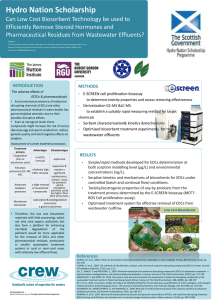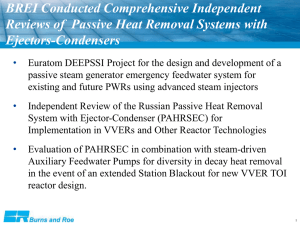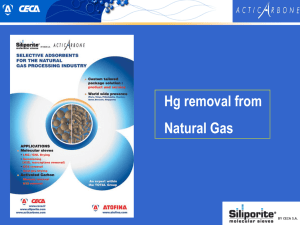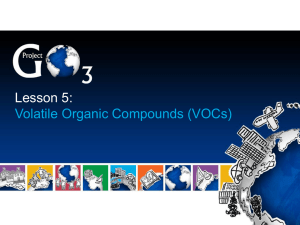Aitken_lecture
advertisement
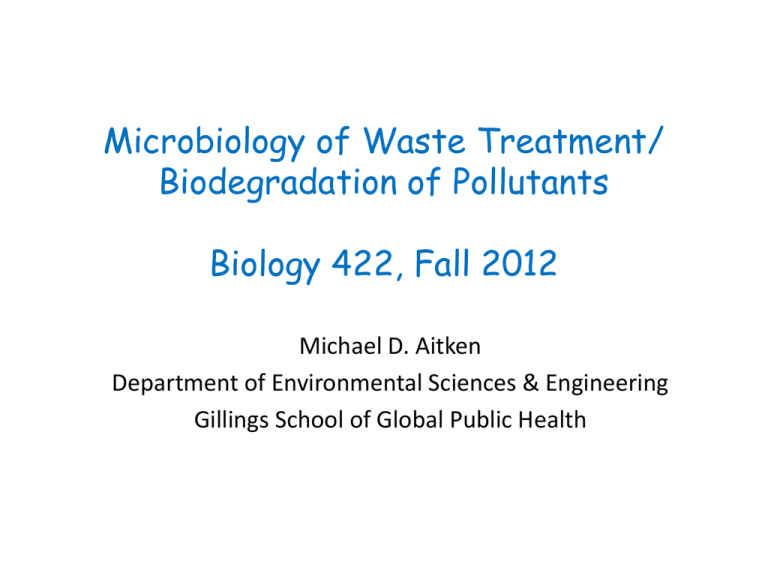
Microbiology of Waste Treatment/ Biodegradation of Pollutants Biology 422, Fall 2012 Michael D. Aitken Department of Environmental Sciences & Engineering Gillings School of Global Public Health What are the pollutants of concern? • domestic wastewater or concentrated animal waste – organic compounds that would deplete oxygen if discharged into surface water (river, stream, lake, estuary, ocean); in aggregate, referred to as “oxygen demand” – inorganic nutrients (N and P) that would stimulate excessive algal growth (eutrophication) in a surface water body – N species that would deplete oxygen in surface water (NH4+) or contaminate groundwater if distributed on land (NO3-) – pathogenic microorganisms and viruses – “emerging contaminants” (e.g., pharmaceuticals, “personal care products”, flame retardants) Pollutants of concern (continued) • domestic solid waste • industrial wastewater – easily degradable organic compounds (e.g., food production, breweries) – specific organic compounds (e.g., commercial products such as pharmaceuticals) – inorganic chemicals (e.g., N, P, S, metals) • hazardous waste – metals – specific organic compounds (e.g., chlorinated solvents, pesticides, aromatic hydrocarbons) Summary of pollutant characteristics • Many pollutants are organic compounds that serve as carbon and energy sources (electron donors) for growth of heterotrophs – many are naturally occurring compounds – some are xenobiotic • Some organic compounds are not known to serve as a carbon or energy source for any microorganism • Some pollutants are inorganic compounds that serve as an energy source for autotrophs – e.g., NH4+ • Some pollutants are terminal electron acceptors required for growth on an energy source (organic or inorganic) – e.g., NO3-, perchlorate (ClO4-), chlorinated hydrocarbons Environmental applications of engineered microbial processes • municipal wastewater treatment (ubiquitous in developed countries) • treatment of some industrial wastewaters • controlled anaerobic decomposition in landfills (“bioreactor landfills”) • composting of solid waste • bioremediation of contaminated soil or groundwater – above-ground (ex situ) or in place (in situ) • biofiltration of contaminated air • common features of all systems – open systems (anyone can join the party!) – complex communities of naturally occurring microorganisms Microbial diversity: an under-explored universe • estimated to be ~ 5 x 106 prokaryotic species (bacteria and archaea) on Earth – we know nothing about most of them • for example: soil can contain thousands of species of prokaryotes per gram – at ~ 3 Mbp per prokaryotic genome, > 1010 bp in “metagenome” of a one-gram soil sample – human genome ~ 3 x 109 bp one gram of soil is genetically more complex than the human genome – abundances range over several orders of magnitude Julian Davies (2006): “once the diversity of the microbial world is catalogued, it will make astronomy look like a pitiful science” Underlying principles of microbial ecology • Every organism has a unique range of capabilities, some of which might be useful in an engineered process • Every organism has a unique range of conditions under which it will grow or at least survive • Environmental systems are likely to be characterized by relatively few dominant species and a large number of low-abundance species • Open environments permit the growth of heterogeneous communities – wastes typically are heterogeneous mixtures of organic and inorganic compounds therefore a diverse community of microorganisms can be expected in a given environmental system, each species with its own “niche” Factors influencing microbial communities • Environmental conditions govern which organisms dominate (which organisms are selected) – – – – – – – major energy and carbon sources dissolved oxygen concentration • aerobes • microaerophiles • anaerobes concentration of other electron acceptors (e.g., NO3-, SO42-, Fe3+) pH (e.g., acidophiles) temperature (psychrophiles, mesophiles, thermophiles) salinity availability of nutrients (e.g., sorbed to a surface or within a non-aqueous matrix vs. dissolved in water) Influencing microbial selection (continued) • Native organisms are almost always better adapted to the local environmental conditions than added organisms would be – creates problems for applications of genetically engineered “superbugs” or commercial cultures • biological process engineering involves control of the microbial community’s immediate environment – – – – dissolved oxygen pH temperature reactor configuration (can control availability of major carbon sources) THEREFORE WE HAVE CONTROL, TO A LARGE EXTENT, OVER MICROBIAL SELECTION. THIS IS THE KEY TO SUCCESS IN THE APPLICATION OF BIOLOGICAL PROCESSES TO WASTE TREATMENT Putting microbial ecology into practice • The science: which organisms do which functions? what conditions do they require to grow and be competitive? • The art: providing conditions to select for the microorganisms that carry out the desired function • The engineering how much? stoichiometry how fast? kinetics how big? design how good? analysis How important is it to know something about the makeup of a microbial community in either waste treatment or bioremediation of a contaminated environment? – depends on the desired function of the process; the more specific the function, the more knowledge is necessary Examples • composting • municipal or • bioremediation of • septic tanks industrial contaminated soils wastewater and sediment • decomposition in landfills treatment • animal waste “treatment” in “lagoons” Technological sophistication low high medium to high Ability to achieve objectives easy easy to moderate Science needed little some to a lot moderate to difficult a lot Overview of municipal wastewater treatment secondary treatment primary treatment preliminary treatment screening raw wastewater grit removal odor VOCs primary sedimentation VOCs filtration nitrification nitrogen removal phosphorus removal nutrient (N&P) removal biological treatment (advanced treatment) primary sludge excess biomass disinfection discharge Municipal wastewater treatment: biological processes screening raw wastewater grit removal odor VOCs primary sedimentation VOCs nitrification nitrogen removal phosphorus removal nutrient (N&P) removal biological treatment (advanced treatment) primary sludge excess biomass disinfection discharge Municipal wastewater treatment: biological processes “activated sludge” – an aerobic suspended culture process nitrification nitrogen removal phosphorus removal nutrient (N&P) removal screening raw wastewater grit removal primary sedimentation biological treatment (advanced treatment) primary sludge “rotating biological contactor” – an aerobic biofilm process excess biomass disinfection discharge Municipal wastewater treatment: biological processes screening raw wastewater grit removal anaerobic digesters odor VOCs primary sedimentation VOCs nitrification nitrogen removal phosphorus removal nutrient removal biological treatment (advanced treatment) primary sludge excess biomass disinfection discharge Municipal wastewater treatment: biological processes odor VOCs screening raw wastewater bioscrubber grit removal primary sedimentation VOCs nitrification nitrogen removal phosphorus removal nutrient removal biological treatment (advanced treatment) primary sludge biofiltration of air in a soil bed excess biomass disinfection discharge Microbial groups in waste treatment • aerobic oxidation of organic compounds: mostly heterotrophic bacteria, some fungi • anaerobic decomposition of organic compounds: hydrogenotrophic methanogens complex organic substrates aceticlastic methanogens fermentative bacteria archaea Microbial groups (continued) • ammonia removal by nitrification (aerobic process): ammonia-oxidizing bacteria: NH4+ + 1.5O2 NO2- + H2O + 2H+ nitrite-oxidizing bacteria: NO2- + 0.5O2 NO3Net: NH4+ + 2O2 NO3- + H2O + 2H+ • denitrification (anaerobic process): facultative heterotrophic bacteria: organic substrates + NO3- N2 note nitrogen removal occurs by nitrification + denitrification • removal of ammonia and nitrogen by anaerobic ammonia oxidation (“anammox”): anaerobic bacteria NH4+ + NO2- N2 + 2H2O • biological phosphorus removal: facultative heterotrophs – under anaerobic conditions, hydrolyze stored polyphosphate to accumulate intracellular organic polymer (e.g., polyhydroxybutyrate) – under aerobic conditions, oxidize stored organic polymer to accumulate phosphate as intracellular poly-phosphate Biodegradation of individual organic chemicals • What is “biodegradation”? – making a pollutant go away? – reducing the impact of the pollutant? • on the environment • on human health General mechanisms of biodegradation • growth-related metabolism – compound is electron donor – compound is electron acceptor • metabolism not related to growth of the organism – if such activity is to be sustained, then a growth substrate has to be provided eventually natural fraction of chemicals supporting growth xenobiotic fraction of chemicals not supporting growth Outcomes of biodegradation mechanisms • complete metabolism (generally associated with growth) – mineralization of a fraction of the initial compound mass to CO2, H2O, Cl-, SO42-, etc.; e.g., aerobic metabolism of glucose: C6H12O6 + 6O2 → 6CO2 + 6H2O mineral (inorganic) products – assimilation of a fraction of the initial compound mass into cellular biomass • incomplete metabolism (usually fortuitous transformation to dead-end metabolites, unrelated to growth) – e.g., transformation of trichloroethylene (TCE) to TCE epoxide by methanotrophs via methane monooxygenase (MMO) MMO C2HCl3 + O2 + NADH + H+ → C2HCl3O + NAD+ + H2O General features of metabolism • whether growth-related or not, virtually all microbial transformations of interest are catalyzed by enzymes • if the compound is metabolized completely, metabolism involves one or more pathways, or sequences of enzyme-catalyzed steps • enzymes are coded for by genes • synthesis of an enzyme requires that the relevant gene(s) be expressed (“turned on”) Problems with non-growth metabolism • the necessary enzyme(s) for transformation of the compound is usually not induced by the presence of the compound • the compound is usually not transformed extensively (may be transformed only one step) – product(s) of incomplete metabolism will accumulate extracellularly – product(s) can be just as toxic as parent compound (or more so) – product(s) might be consumed by other organisms; this is one advantage of microbial communities over pure cultures • competition between the pollutant and the “natural” substrate for the enzyme(s) capable of transforming the pollutant must be considered Postulates for biodegradation • a biochemical mechanism for transformation or complete metabolism of the compound must exist • one or more organisms possessing the relevant gene(s) must be present in the system – indigenous organisms – organisms inoculated into system (bioaugmentation) • gene(s) coding for the relevant enzyme(s) must be expressed – by the compound itself – induced by some other means • mechanism must be manifested Why biodegradation mechanisms might not be manifested • limited bioavailability (generally an issue for hydrophobic chemicals, particularly in the subsurface) • concentration effects – substrate inhibition at high concentration – concentration too low to support growth • inhibition by other chemicals in the system • other conditions not favorable – pH – nutrient limitations – electron acceptor limitations

